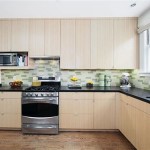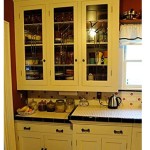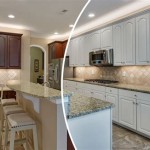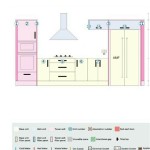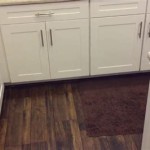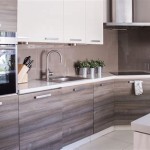Ideas For Decorating The Top Of Kitchen Cabinets
The space above kitchen cabinets often presents a design challenge. This area, frequently unused and accumulating dust, possesses considerable potential for enhancing the overall aesthetic of a kitchen. Effective utilization of this space can add visual interest, complement the existing decor, and even create an illusion of height. This article explores various strategies for decorating the tops of kitchen cabinets, focusing on practical and visually appealing options.
Strategic Use of Greenery
Incorporating greenery is a popular and effective method for decorating the tops of kitchen cabinets. Plants introduce a touch of nature, softening the often-stark lines of cabinetry. Artificial plants offer a low-maintenance solution, particularly suitable for areas that are difficult to reach for watering. Consider using trailing varieties, such as ivy or pothos, which can cascade gracefully over the edge of the cabinets, creating a visually appealing effect. Alternatively, potted plants, either real or artificial, can be arranged in groups of varying heights to add dynamic interest. When selecting plants, consider the style of the kitchen. For example, a modern kitchen might benefit from sleek, architectural plants like snake plants or succulents, while a farmhouse kitchen might suit more traditional options like ferns or herbs.
The arrangement of greenery is crucial. Avoid overcrowding; instead, aim for a balanced and visually pleasing composition. Groupings of three or five plants often work well, and varying the textures and colors of the foliage can enhance the visual impact. Consider using decorative pots that complement the kitchen's color scheme and overall design. Terra cotta pots offer a rustic charm, while sleek ceramic pots provide a more contemporary look. Ensure that the pots are stable and secure on top of the cabinets to prevent them from falling.
For kitchens with limited natural light, opting for artificial plants is a practical choice. High-quality artificial plants are now available that closely mimic the appearance of real plants, offering a realistic and aesthetically pleasing solution. Regularly dust artificial plants to maintain their appearance and prevent them from looking artificial. Seasonal changes can also be reflected by swapping out greenery. Consider adding festive plants during holidays or switching to different foliage to match the changing seasons, further enhancing the kitchen's overall ambiance.
Displaying Decorative Items
Utilizing the space above kitchen cabinets to display decorative items offers a personalized touch and the opportunity to showcase collectibles or treasured pieces. This strategy allows for the incorporation of items that might otherwise clutter countertops or shelves. The key to successful display lies in careful selection and arrangement, ensuring that the items complement the kitchen's style and create a cohesive look.
A curated collection of items, rather than a haphazard assortment, is essential. Consider displaying items that share a common theme, color palette, or style. For example, a collection of vintage pitchers, antique cookbooks, or ceramic vases can create a unified and visually appealing display. Grouping items of varying heights and shapes adds visual interest and prevents the display from appearing monotonous. Use risers or platforms to elevate some items, creating a sense of depth and dimension. The number of items displayed should be carefully considered. Overcrowding can make the space look cluttered and disorganized. It is often more effective to display fewer items, allowing each piece to stand out and be appreciated.
The style of the decorative items should align with the overall design of the kitchen. A farmhouse kitchen might benefit from displaying vintage signs, wooden crates, or antique kitchen tools. A modern kitchen might feature minimalist sculptures, geometric vases, or abstract art. Consider the color palette of the kitchen and choose items that complement the existing colors. A neutral color scheme allows for the introduction of pops of color through decorative items, while a more colorful kitchen might benefit from a more subdued and complementary palette. Regularly dust the displayed items to maintain their appearance and prevent them from becoming unsightly. Consider rotating the display seasonally to keep the look fresh and interesting.
Creating a Faux Architectural Feature
Transforming the space above kitchen cabinets into a faux architectural feature can significantly enhance the kitchen's overall design and create a sense of grandeur. This approach involves incorporating elements that mimic built-in architectural details, such as crown molding, corbels, or even a faux transom window. This strategy requires careful planning and execution, but the results can be transformative, adding character and visual interest to the kitchen.
Adding crown molding to the top of the cabinets is a relatively simple and cost-effective way to create a more finished and polished look. Crown molding bridges the gap between the cabinets and the ceiling, creating a seamless transition and adding a touch of elegance. Choose crown molding that complements the style of the cabinets and the overall design of the kitchen. Paint the molding the same color as the cabinets for a cohesive look, or choose a contrasting color for a more dramatic effect. Corbels, decorative brackets that support the underside of an overhang, can also be added to the cabinets to enhance their architectural appeal. Position corbels strategically along the top of the cabinets to add visual interest and create a sense of depth.
A faux transom window, a decorative window-like structure mounted above the cabinets, can create the illusion of added height and natural light. This is particularly effective in kitchens with limited natural light or low ceilings. The faux transom can be constructed from wood or other materials and decorated with glass or decorative panels. Consider adding lighting behind the transom to create a soft and ambient glow. The architectural feature should be proportional to the size of the cabinets and the kitchen. An overly large or elaborate feature can overwhelm the space, while a feature that is too small can appear insignificant. The key is to create a balanced and harmonious design that enhances the overall aesthetic of the kitchen. Ensure that the architectural feature is securely mounted to the cabinets to prevent it from falling. Regularly clean the feature to maintain its appearance and prevent dust accumulation.
Lighting Considerations
Illuminating the space above kitchen cabinets can significantly enhance the visual impact of any decorative elements placed there. Strategic lighting not only draws attention to the decorated area but also adds ambient light to the kitchen, creating a warmer and more inviting atmosphere. Various lighting options are available, each offering different effects and requiring different installation methods.
LED strip lights are a popular choice for under-cabinet and above-cabinet lighting due to their energy efficiency, versatility, and ease of installation. These lights can be easily adhered to the top of the cabinets, providing a consistent and even glow. Choose LED strip lights with adjustable brightness to control the intensity of the light. Warm white light creates a cozy and inviting atmosphere, while cool white light offers a brighter and more modern feel. Puck lights, small round lights that can be surface-mounted or recessed, are another option for illuminating the space above cabinets. These lights are particularly effective for highlighting specific decorative items or creating focal points. Consider using dimmer switches to control the brightness of the puck lights and create different moods.
Rope lights, flexible tubes containing small incandescent or LED bulbs, are a versatile option for adding ambient lighting to the kitchen. These lights can be easily shaped and positioned to follow the contours of the cabinets. Choose rope lights that are designed for indoor use and ensure that they are securely mounted to prevent them from falling. The choice of lighting should complement the style of the kitchen and the decorative elements displayed above the cabinets. A modern kitchen might benefit from sleek and minimalist lighting fixtures, while a farmhouse kitchen might suit more rustic and traditional options. Ensure that the lighting is installed safely and in accordance with local electrical codes. Consider hiring a qualified electrician to install any hardwired lighting fixtures. Regularly clean the lighting fixtures to maintain their brightness and prevent dust accumulation. The type of lighting selected should not create excessive heat that could damage the cabinets or decorative items.
Maintaining Cleanliness and Order
Regardless of the chosen decorating strategy, maintaining cleanliness and order above kitchen cabinets is paramount. This space is prone to accumulating dust, grease, and other debris, which can detract from the overall appearance of the kitchen. Regular cleaning and maintenance are essential to ensure that the decorated area remains visually appealing and hygienic.
Dusting the tops of kitchen cabinets should be a regular part of the kitchen cleaning routine. Use a long-handled duster or vacuum cleaner with a brush attachment to remove dust and debris. Pay particular attention to corners and crevices where dust tends to accumulate. For grease and stubborn stains, use a mild detergent and a soft cloth to gently clean the surface of the cabinets. Avoid using abrasive cleaners or scouring pads, which can damage the finish. Decorative items displayed above the cabinets should also be regularly dusted and cleaned. Remove the items from the cabinets and dust them individually before returning them to their place. Washable items can be cleaned with soap and water, while delicate items may require special cleaning solutions.
Consider using shelf liners or mats to protect the tops of the cabinets from dust and debris. These liners can be easily removed and cleaned, making maintenance easier. Avoid storing items that are prone to attracting dust or pests above the cabinets. For example, avoid storing open bags of food or paper products. Periodically inspect the tops of the cabinets for signs of leaks or water damage. Address any issues promptly to prevent further damage. The effort invested in decorating the tops of kitchen cabinets will be negated if the area is not properly maintained. Regular cleaning and maintenance are essential to ensure that the decorated area remains a visually appealing and hygienic addition to the kitchen.

19 Decorating Ideas For Adding Some Flair To The Top Of Your Kitchen Cabinets Decor Above

Update Your Kitchen On A Budget Cabinets Decor Decorating Above
:strip_icc()/101705919-46c69aadc4b1401fbb8383b607c37b36.jpg?strip=all)
16 Ideas For Decorating Above Kitchen Cabinets

18 Ideas For Decorating Above Kitchen Cabinets Design Top Of

Decorating Above Kitchen Cabinets Beyond The Wood Diy Tips And Tricks

How To Decorate Above Kitchen Cabinets Modern Farmhouse

How To Decorate Above Kitchen Cabinets Modern Farmhouse
How To Decorate The Top Of A Cabinet And Not Designed

Decorating Above Kitchen Cabinets Ideas Tips

How To Decorate Above Kitchen Cabinets Modern Farmhouse
Related Posts

